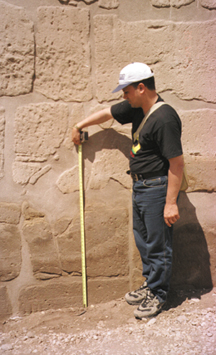
Geotimes Home | AGI Home | Information Services | Geoscience Education | Public Policy | Programs | Publications | Careers

 The problem was first
identified as afflicting the great Sphinx of Giza in the early 1980s. When the
government provided a sewage system for the neighboring village, the water table
below the Sphinx dramatically dropped and the salts stopped their intrusion. But
elsewhere the problem continues.
The problem was first
identified as afflicting the great Sphinx of Giza in the early 1980s. When the
government provided a sewage system for the neighboring village, the water table
below the Sphinx dramatically dropped and the salts stopped their intrusion. But
elsewhere the problem continues.  |
Geotimes Home | AGI Home | Information Services | Geoscience Education | Public Policy | Programs | Publications | Careers |